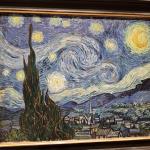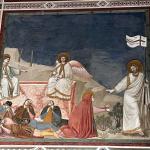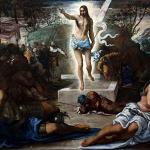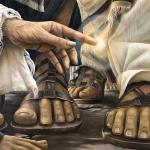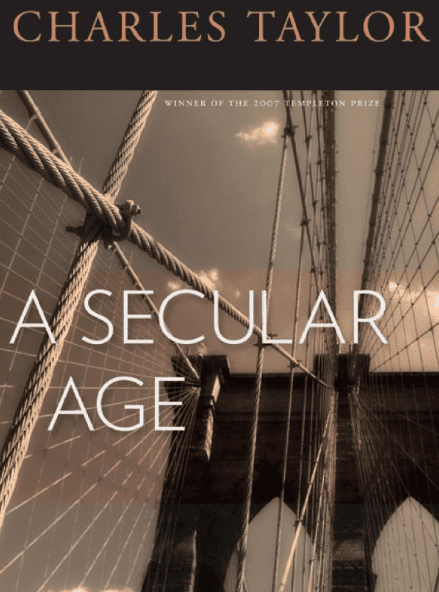 This is by one of our Northern (MA New Testament) students, Ben Davis, who leads a pastors group in Wichita KS.
This is by one of our Northern (MA New Testament) students, Ben Davis, who leads a pastors group in Wichita KS.
Synopsis of A Secular Age
Charles Taylor’s book, A Secular Age, is a sweeping narrative covering more than 500 years of philosophical, theological, political, and cultural history in an effort to answer this singular question: “Why was it virtually impossible not to believe in God in, say, 1500 in our Western society, while in 2000 [or 2019] many of us find this not only easy but even inescapable?” (25). By answering this critical question, Taylor’s narrative makes clear that secularism was not determined before the foundation of the universe. Rather, what gave rise to our secular age was a series of contingent historical events whose results could have been otherwise. To be clear: secularism is a matter of choice; not fate.
First, it is important to understand the nature of the secular as Taylor defines it. The thesis of his book is predicated on three aspects of the secular that are listed in turn:
- Secular: Like the sacred, the secular is a way of marking time. For example, Sunday’s Eucharist or morning and evening prayer mark sacred time; while work, eating meals, or going to festivals mark secular time.
- Secularism: Post Enlightenment, the secular becomes secularism. For the first time it means a lack of belief in God and religious practice. For instance, the nation-state becomes a secular (i.e. ‘neutral’) institution where religious belief and practice are severely limited if not prohibited entirely.
- Secularity: “The shift to secularity in this sense consists, among other things, of a move from a society where belief in God is unchallenged and indeed, unproblematic, to one in which it is understood to be one option among others, and frequently not the easiest to embrace.”
Second, it is important to remember that Taylor is telling a story. What follows, then, is a tenuous effort to sketch the broad contours of that narrative as Taylor tells it.
(1) Taylor contends that for most of human history the world was enchanted: “The natural world. . . testified to divine purpose and action; . . . storms, droughts, floods, plagues, as well as years of exceptional fertility and flourishing, we seen as acts of God. . .” (25). In this enchanted world, not only was God (or something like God) assumed, but personal identity was conferred, not created. Persons understood themselves to be one link in the chain of the great Order of Being, moving effortlessly between the borders of the natural and the supernatural realms. Accordingly, persons were porous – open and connected to the spiritual world surrounding them. Their social imaginary presumed that reality was saturated by meta-physical forces haunting creation, interacting with them in a dynamic matrix that was indisputable.
(2) Then something changed. Reform moved through western Europe with a blustering force, profoundly altering the religious and political landscape with dramatic effect. One consequence of Reform was the proliferation of confessional identities that (re)defined the borders of Europe. While the essence of the Reformation(s) was good and indispensable to righting the course of the Church’s history, it left some devastating if unintended consequences in its wake. For example, rival ecclesial bodies – Roman Catholic, Lutheran, Anglican, Huguenot (Reformed), and Anabaptist – vied to solidify political power and violence inevitably ensued, resulting in what is known today as the “Wars of Religion.”
(3) Exhausted by interminable war(s) and unable to secure the grounds for truth among competing theological factions, a new movement came to birth primarily in France, Prussia (Germany), and England which sought to find a way forward beyond theological and ecclesial foundations. This movement is known as the Enlightenment. What is important to understand about the Enlightenment is that it was in part the product of theological motivations. Apostles of reason such as Immanuel Kant and John Locke were arguably serious Christians who espoused faith in the Christian God as a matter of first importance. Part of their Enlightenment project, however, was to ground claims of truth and knowledge – especially truth and knowledge about God — somewhere other than in religious sources, such as the Bible, which had become a touchstone of controversy. For the sake of peace and tolerance, they thought, society needed to find a more theologically ‘neutral’ means by which to adjudicate competing notions of truth and authority. This transition leads to what Taylor calls excarnation – the notion that, based on reason alone, religion is reducible to competing systems of belief that one merely comprehends rationally but does not know imaginatively, sacramentally, or practically (through embodied practice). Each system of belief is then measured according to its veracity vis-à-vis reason alone, isolated from any notion of history, tradition, or community of practice.
Thus: as the heart of Reformation doctrine came to be summed up in the five Solas, so the heart of Enlightenment doctrine came to be summed up in just one: sola ratio. Reason alone would be the fulcrum around which human understanding turned. Either religion is rational – justified by reason alone – or it is nothing more than superstition.
(4) But over time even reason proved to be too fragile a basis on which to secure peace and unity for an increasingly diverse, beleaguered society. With the rapid rise of natural science, economic industrialization, and the secular nation-state, the world became more disenchanted. As the crust of the immanent frame hardened over religious, political, and social order, many people eschewed the doctrine of sola ratio, looking for intimations of the sacred in places such as art, poetry, and nature. According to Taylor’s story, it’s the era of Romanticism that hastens the nova effect. The nova effect posits three distinct features:
- Secularism morphs into secularity. Disbelief becomes a viable force against Christian belief and practice, and public space is increasingly stripped of any overt religious symbolism.
- Alternative ways of being other than Christian multiply and challenge conventional belief and practice. Atheism becomes not merely disbelief in God but rather a comprehensive framework by which to understand reality.
- As new horizons of freedom open up, the age of authenticity is born.
Since one’s identity was no longer conferred by God, or located in the Order of Being, then one was free to (re)create it according to one’s will. On that score, individual autonomy, self-expression, and feeling become moral ideals. As Taylor aptly puts it: “the understanding of life which emerges with the Romanic expressivism of the late-eighteenth century, that each one of us has his/her own way of realizing our humanity, and that it is important to find and live out one’s own, as against surrendering to conformity with a model imposed on us from outside, but society, or the previous generation, or religious or political authority.” (475)
Under the cloud of Romanticism belief in God was not unthinkable; indeed, it is accurate to say that a majority of people in the West at the advent of the 19th and 20th centuries still maintained a semblance of belief in God if not a robust Christian faith. But for the first time in history disbelief in God was a viable option for people who sought meaning elsewhere. Two additional features also became significant at this time. (1) The self – once porous in a world of enchantment – was now buffered and enclosed. Reality could be solely understood in a natural, scientific register. (2) A captivating narrative emerges that Taylor calls the subtraction story. In short, the subtraction story suggests that as modernity progresses and solidifies in our social imaginary, religious belief is subtracted from our lives altogether. Thus:
TIME
______________________________>
religion < MODERNITY
(5) Today — after two World Wars, the fall of the Soviet Union, the rise of globalization, and the rapid expansion of technology – the world is a profoundly different place than it was 500 years ago. Belief in God – or some kind of transcendence – still exists, to be sure. It is the conditions of belief that have changed, however. Now, even those who espouse strong, stable religious convictions are squeezed by what Taylor calls cross-pressures (e.g. science, technology, competing ‘life-styles’), dilemmas (e.g. evil, suffering, gratuitous violence) and alternative narratives of flourishing that contend for one’s allegiance and shape one’s understanding of God and the world.
In the immanent frame, seemingly everyone is aspiring toward some idea of fullness; but it can no longer be assumed that fullness is necessarily or primarily found in God. Many people are comfortable locating fullness in humanitarian relief, technological innovation, political progress, or theories of self-improvement. There are as many paths of meaning now available to choose from as there are flavors of ice cream. Yet the malaise of modernity persists. It is a palpable awareness that something is missing from our lives. This heavy sense of loss and equally deep sense of longing are opposite sides of the same reality in our fractured, secular age. Ironically, as modernity expands, its subtraction story turns out to be a myth; the search for the sacred remains inescapable. But the single path once set before our distant ancestors has now splintered in many disparate, irreconcilable directions.
To say it again: our secular age is not a permanent fixture of history. The next chapter in the story of human events could witness its collapse – or its stratification. We have every reason to think religious belief and practice will continue. But what form it will take is unknown.











